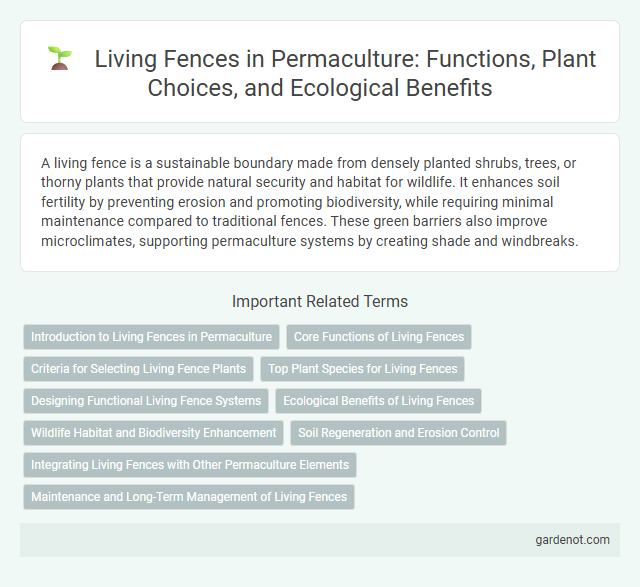A living fence is a sustainable boundary made from densely planted shrubs, trees, or thorny plants that provide natural security and habitat for wildlife. It enhances soil fertility by preventing erosion and promoting biodiversity, while requiring minimal maintenance compared to traditional fences. These green barriers also improve microclimates, supporting permaculture systems by creating shade and windbreaks.
Introduction to Living Fences in Permaculture
Living fences in permaculture serve as multifunctional boundaries composed of carefully selected plants that offer ecological, economic, and social benefits. These natural barriers enhance soil stability, support biodiversity by providing habitat for beneficial insects and wildlife, and reduce the need for synthetic fencing materials. Common species used include nitrogen-fixing trees, thorny shrubs, and fast-growing vines, which collectively promote a sustainable and resilient landscape design.
Core Functions of Living Fences
Living fences serve as natural barriers that provide security, privacy, and wind protection while enhancing biodiversity by offering habitat and food sources for beneficial wildlife. They contribute to soil stabilization and erosion control through extensive root systems that improve soil structure and nutrient cycling. These fences also act as carbon sinks, supporting climate regulation and sustainable land management in permaculture design.
Criteria for Selecting Living Fence Plants
Selecting living fence plants in permaculture involves prioritizing species that are fast-growing, hardy, and native to the local ecosystem to ensure sustainability and low maintenance. Plants should also possess characteristics such as dense foliage for effective privacy and wind protection, deep root systems for soil stabilization, and the ability to fix nitrogen or provide additional yields like fruit or fodder. Considering pest resistance, adaptability to soil and climate conditions, and compatibility with surrounding crops enhances the overall productivity and ecological balance of the living fence.
Top Plant Species for Living Fences
Top plant species for living fences in permaculture include native thorny shrubs like hawthorn (Crataegus monogyna) and blackthorn (Prunus spinosa), which provide effective natural barriers and wildlife habitats. Fast-growing trees such as moringa (Moringa oleifera) and gliricidia (Gliricidia sepium) are valued for their dense foliage and nitrogen-fixing properties, enhancing soil fertility and fence durability. Incorporating multi-purpose plants like bamboo (Bambusoideae) offers both structural strength and rapid regeneration, making it ideal for sustainable, living boundary solutions.
Designing Functional Living Fence Systems
Designing functional living fence systems in permaculture involves selecting diverse, native plant species that provide structural integrity, habitat for wildlife, and multi-purpose yields such as food, medicine, or fuel. Strategic spacing and layering optimize sunlight capture, soil retention, and biodiversity support while creating effective barriers against pests and erosion. Integrating nitrogen-fixing plants and dynamic accumulators enhances soil fertility, promoting resilient and self-sustaining ecosystems.
Ecological Benefits of Living Fences
Living fences enhance biodiversity by providing habitat and food sources for pollinators and beneficial insects, improving overall ecosystem health. They reduce soil erosion and increase soil fertility through natural root systems that stabilize the ground and promote nutrient cycling. These green barriers also act as windbreaks, decreasing wind velocity and protecting crops from damage, while sequestering carbon to mitigate climate change impacts.
Wildlife Habitat and Biodiversity Enhancement
Living fences in permaculture act as vital wildlife habitats by providing shelter, nesting sites, and food sources for a wide variety of species, promoting ecosystem balance. These green barriers enhance biodiversity by supporting pollinators, birds, and beneficial insects, contributing to pest control and plant health. Integrating native plants within living fences maximizes ecological benefits and fosters resilience in agroecosystems.
Soil Regeneration and Erosion Control
Living fences, composed of densely planted shrubs or trees, enhance soil regeneration by promoting nutrient cycling and organic matter accumulation. Their extensive root systems stabilize soil structure, significantly reducing erosion by holding topsoil in place during heavy rains. This natural barrier supports biodiversity while improving soil fertility, making it a sustainable solution for land management in permaculture systems.
Integrating Living Fences with Other Permaculture Elements
Living fences enhance permaculture systems by providing habitat corridors that support beneficial insects and wildlife, promoting biodiversity and natural pest control. Integrating living fences with companion planting and edible landscapes maximizes space efficiency while improving soil health through root diversification and organic matter accumulation. These multifunctional barriers also act as windbreaks and microclimate regulators, boosting overall garden productivity and resilience.
Maintenance and Long-Term Management of Living Fences
Living fences require regular pruning and monitoring to maintain plant health and structural integrity, preventing overgrowth and encouraging dense, thorny barriers ideal for pest control. Soil fertility management through mulching and periodic fertilization supports sustained growth and resilience against pests and diseases. Long-term management includes replacing weakened plants promptly and adapting species choice to evolving environmental conditions, ensuring the fence remains effective and sustainable over time.
Living fence Infographic

 gardenot.com
gardenot.com